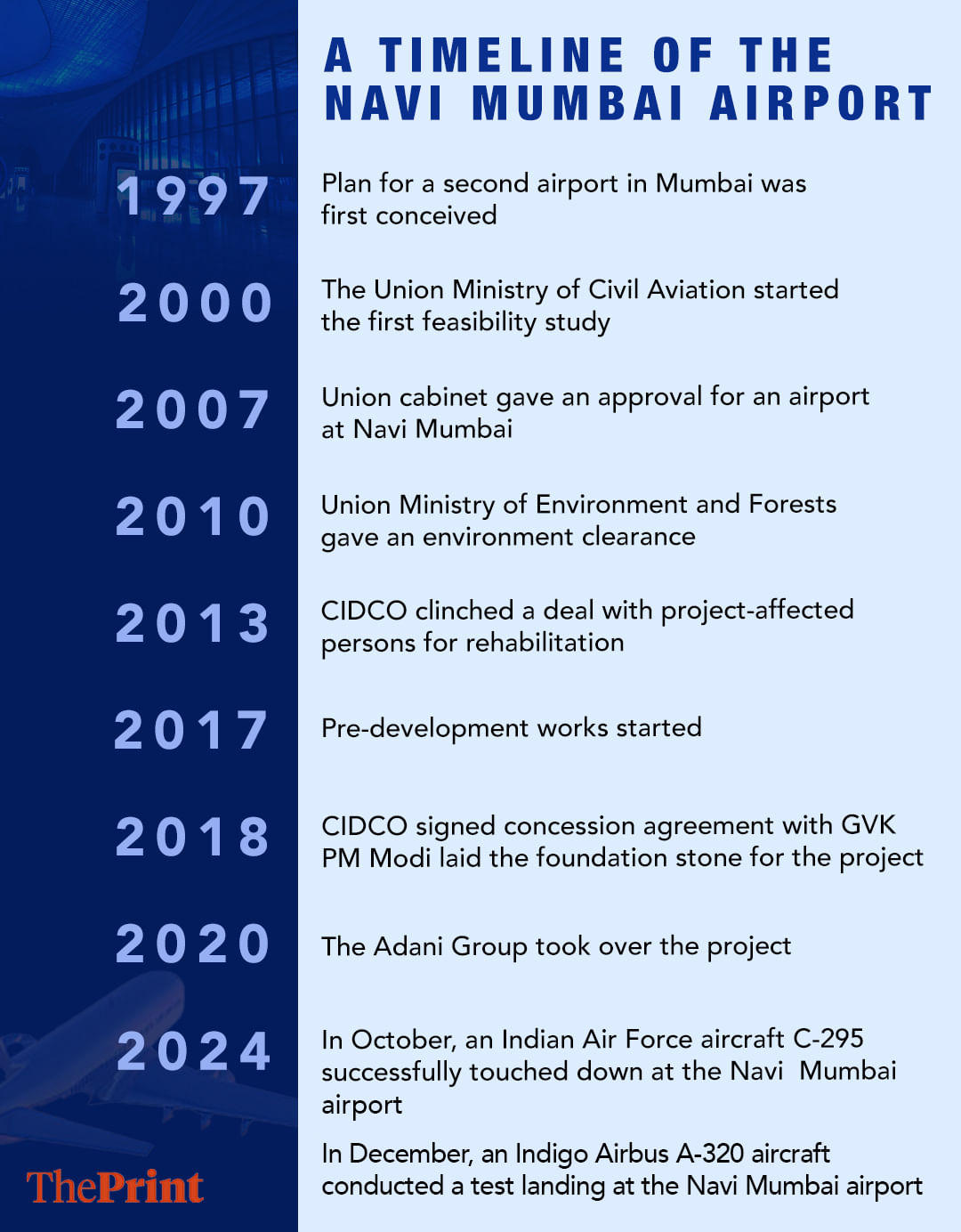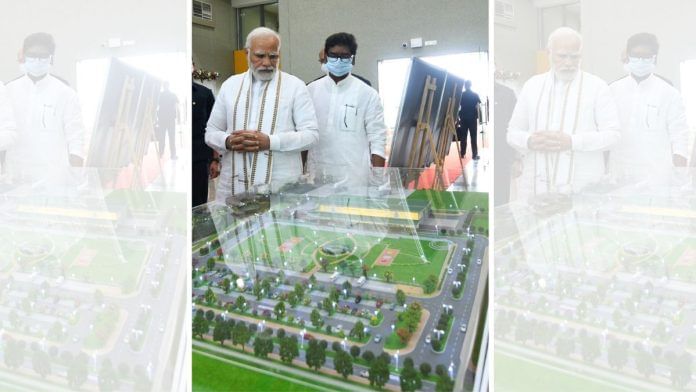Mumbai: When IAS officer Vijay Singhal took charge as the managing director of the City and Industrial Development Corporation (CIDCO) in February 2024, the first thing he did was visit the site of the under-construction Navi Mumbai airport.
It did not seem that the airport, which by then had been on a 27-year-long journey, was anywhere close to completion. Only half of the terminal had a runway; the other half was still covered by a hill waiting to be cleared, Singhal told reporters in an interaction on Sunday.
On Wednesday, Prime Minister Narendra Modi will inaugurate the first phase of the Navi Mumbai airport, thereby bringing a long, arduous, and politically and environmentally challenging project to some level of fruition. With this, the Mumbai Metropolitan Region—the urban agglomeration of Mumbai and its outskirts—will have its second major airport to take some load off the bustling Sahar airport.
However, flight operations—both domestic and international—will only begin in December, pending approval from the Central Industrial Security Force (CISF).
Singhal told reporters, “The CISF does a full security sweep. They have a 45-day procedure, only after which we can start this airport for commercial operations.”
He also elaborated on how CIDCO fast-tracked work on the Navi Mumbai airport over the last 18 months to reach a stage where a single integrated terminal (T1) is now fully ready. The plan is to have a total of four terminals built in subsequent phases.
“I must have visited over 30 times and taken many more meetings. There were many complexities… the project has had a long journey, and many people have contributed to it—the farmers, people living there [at the airport site], and former managing directors of CIDCO, as well as joint managing directors and the many engineers. We can’t deny anyone’s role,” Singhal said.
The airport is being seen as a project that will not only enhance Mumbai’s air traffic capacity but also spur development in different parts of the city.
On the Mumbai side of the harbour, neighbourhoods along the eastern seafront—from where the Atal Setu connecting to the Navi Mumbai airport has been built—have already seen increased demand, with more connectivity projects in the pipeline.
The under-construction Sewri-Worli connector to speed up traffic from the western suburbs, as well as the proposed underground Metro corridor from Wadala to the Gateway of India, connecting Sewri, will likely further accelerate movement.
On the mainland, CIDCO has multiple infrastructure projects planned around the 22-km Sewri-Nhava Sheva Atal Setu and the Navi Mumbai airport. These projects will spur residential and commercial developments such as the Ulwe coastal road, a Metro line connecting the two airports, and a new planned city in the airport’s influence area.
The 28-year wait with twists & turns
The Navi Mumbai International Airport was first conceived in November 1997 when the Union government identified the need for a second airport in Mumbai. The Ministry of Civil Aviation constituted a committee to study its feasibility. However, it took another ten years for the project to reach a stage where it could get the ministry’s final approval for implementation. And then, it took another decade for construction to begin.
Meanwhile, the project continued to face multiple roadblocks—from disagreements over the airport’s location to obtaining environmental clearance and acquiring land.
The civil aviation ministry’s report in 2000 first recommended Rewas-Mandwa in the Raigad district as the most preferred location.
However, the then Maharashtra government, formed by the Congress and the undivided Nationalist Congress Party (NCP), considered connectivity and proximity to Mumbai to suggest Navi Mumbai as a better location.
The Union Cabinet finally gave its in-principle approval for the construction of the airport at Navi Mumbai in 2007. However, the location continued to be debated throughout the process of obtaining the environmental and wildlife clearances.
The Union Ministry of Environment, Forests, and Climate Change, as well as green activists, opposing the project, insisted on exploring locations such as Rewas-Mandwa, Kalyan, and Wada. Meanwhile, the Union Ministry of Civil Aviation, as well as the Maharashtra government, maintained that the sites suffered from several technical and locational disadvantages.

Also Read: 3rd abrupt halt in a month: Poor ridership & shoddy upkeep are catching up to Mumbai monorail
The red over the green
The process of obtaining environmental clearance led to a political conflict between the then-Union Civil Aviation Minister Praful Patel, an NCP leader, and the then-Union Environment Minister Jairam Ramesh, a Congress leader.
Patel alleged that Ramesh was delaying the project. Meanwhile, Ramesh raised several environmental objections related to the cutting of a hill, diverting rivers, and clearing mangroves.
In March 2008, Ramesh’s ministry refused to grant the project environmental clearance. It cited the destruction of mangroves and a violation of a 2005 Bombay High Court order that had frozen the destruction of mangrove forests in Maharashtra and banned construction within 50 metres of them.
The Ministry of Environment, Forests and Climate Change (MoEF&CC) asked the state government to get a nod from the Bombay High Court. Concerns were raised over the large-scale destruction of mangroves, the flattening of a hill, and the diversion of two rivers.
Finally, after much back and forth, in November 2010, the Union MoEF&CC granted clearance for the Navi Mumbai airport project, with some modifications, which CIDCO accepted “without affecting the proposed capacity and efficiency of the airport”, according to the minutes of a November meeting of the Maharashtra Coastal Zone Management Authority (MCZMA).
A CIDCO official told the MCZMA that with the changes, the total area affected by mangroves would be 98 hectare, down from the earlier proposed 161 hectare. As part of the changes, CIDCO had agreed to shift the airport’s non-aeronautical and commercial activities to a non-Coastal Regulation Zone (CRZ) area.
While the earlier proposal required the diversion of both the Gadhi and Ulwe rivers, CIDCO agreed to retain the Gadhi river in its natural course and create a 75-metre-wide channel at the confluence of the Gadhi and Ulwe to facilitate run-off from the airport and avoid flooding. In the revised proposal, CIDCO agreed to develop a mangrove park on either side, totaling 615 hectare, and reduce the distance between the two runways.
Regarding the objections to flattening the hillock, Ramesh, while granting clearance, said, “The 90-metre-high hill will need to be removed to enable smooth access to the runways. It has already been quarried, so the ecological value of the hill is virtually zero.”
An airport taking shape
The airport is being built across 1,160 hectare—the site of 12 villages with nearly 3,500 families that had to be rehabilitated as part of the pre-development work. This process was time-consuming, as a majority of the villagers did not want to give up their land.
CIDCO eventually clinched a deal with landowners to acquire 671 hectare of private land in 2013 by working out a unique compensation model, which has since become a precedent for most mega projects in Maharashtra. It involved making the project-affected persons stakeholders by giving them 22.5 percent of their acquired land with additional Floor Space Index, shares totaling two percent of the equity in the new company, alternate land three times the size of their current residence, and job guarantees for their children.
The other pre-development works—clearing the site by flattening the hill, clearing marshy land, diverting the Ulwe, and raising the land by 8.5 metre—started in 2017 after most of the rehabilitation was completed and took a considerable amount of time.
In 2018, PM Modi laid the foundation stone for the project a month after CIDCO signed a concession agreement with the GVK Group, following a long-drawn tendering process. The then-Chief Minister Devendra Fadnavis set an optimistic deadline of completing the project in 2019, even as officials said 2021 was a more realistic deadline.
While it looked like the stars had finally aligned for the Navi Mumbai airport project, its struggles were far from over.
Hampered by the COVID-19 pandemic and lockdown, the project suffered further delays. A financial strain on the original concessionaire, the GVK Group, also prompted a change in management in 2020, when the Adani Group took over.
During this entire journey, the cost has surged manifold. According to one of the proposals filed by CIDCO with the MoEF&CC in 2010, the estimated cost for all four phases of the airport, based on prices in 2008-09, was Rs 8,722 crore.
According to Singhal, the total cost of the first phase alone has now escalated to Rs 19,647 crore. When all four terminals are complete, it will go up to Rs one lakh crore, he added. In its first phase, the airport is expected to have a passenger capacity of 20 million per annum and a cargo capacity of 0.8 million metric tonnes.
Three more phases of the airport remain to be completed. The next terminal would be ready by 2029, the third by 2032, and the last by 2035-36. Once all four terminals are complete, the airport is expected to have the capacity to handle 90 million passengers per annum, slightly more than the current capacity of London’s Heathrow airport—83.9 million passengers in 2024.
The combined capacity of both the Navi Mumbai International Airport and the Mumbai International Airport at Sahar, which handled 55.1 million passengers in FY2024-25, will be nearly 145 million passengers per annum.
(Edited by Madhurita Goswami)
Also Read: Gandhi’s ‘Purna Swaraj’ speech, farmers’ march to Jarange’s mutiny—Azad Maidan’s legacy of dissent





